#its more a sci-fi book but psychic powers!! :D
Note
1 do you prefer a standalone or a series?
11 the best book you have ever read?
20 do you prefer audio books or e-books?
Elli, I love you for changing out those pesky shorthand yous. <3 Thanks for the ask! From this ask game.
1. do you prefer a standalone or a series?
Most definitely prefer a series. I get attached to these little fuckers and I *always* want more. Honestly, it is exceedingly rare for me to even find a standalone I want to read anyway, but *shrugs*
Also, I prefer a series that follows the same cast of characters, but I'll take reading about a new set of mc's as long as the old ones still feature in the book :)
11. the best book you have ever read?
Fuck this question 😂
The best, how? Like best written? best as in favorite? I guess I'll go with favorite? (which also, fuck picking favorites lolol)
Mostly bc I'm not a great judge of literary quality. I'm in it for the characters and there are some truly awful books written that the characterization completely makes up for, so take that as you will lol.
...
...
I've been staring at this question for waaaaay too long. Also super hard to pick a singular book (reference first question lol)
Not gonna say its the best 😑, but The Rowan by Anne McCaffrey is a particular favorite of mine from way back when. It's part of a series, but it's the one I like most.
The Rowan is caught in a landslide that orphans her as a toddler, trapped in a vehicle for days while the entire planet listens to a baby wail psychically in their minds. Once rescued, she grows up with a handler's family. She is a strange traumatized child who keeps to herself, and is way way too strong (psychically).
She is set apart and isolated her entire life, either by her own choice or by the cruelty of others, and the whole book is just one blow after another until she walls herself off completely.
But she finds love and acceptance at the end and its just so 🥰🥰
20. do you prefer audio books or e-books?
ebooks ebooks ebooks ebooks ebooks
*comes up for air*
ebooks?
#literally spent 30 min trying to come up with ONE book 😅😭#i have trouble choosing stuff lol#good book though#they didn't know her name either and named her after the mining town she used to live in#she eventually learns her name way later but chooses to the rowan#yes. The Rowan not just rowan lol#oh and she was given an interactive doll called a pookha bc she wouldn't speak for the longest#but one of the kids she lived with destroyed it bc they knew she loved it 😭😭#its more a sci-fi book but psychic powers!! :D#starlit asks#i can even burn salad
3 notes
·
View notes
Text
The ATOM Create a Kaiju Contest 3-D: Entry Roundup
You’ve been patiently waiting for the results of the ATOM Create a Kaiju Contest 3-D, and now... you have to wait a bit longer, but at least you’ve got an entry roundup with lots of sketches and a good bit of feedback for all the entrants! My goal is to get the finalists illustrated in a week or two, and after that, the grand prize winner will be announced. But, for now, the official entry roundup! After the cut:
I should note that while I sketched these in the order they were submitted, my scanner saved the documents with random names, so they’re a bit jumbled. You know, just in case you’re like me and would get confused noticing that it’s almost in chronological order but with some entries jumbled around.

@bugcthulhu’s Obsideban was designed as a counterpart to Rohobaron - the Black King to Rohobaron’s Red King, if you will. Or, well, Black Queen in this case, as Obsideban also takes her personality from the “delinquent girl” archetype in Japanese media. Bug’s designs always ooze personality, and I had a lot of fun translating this big, gnarly retrosaur into my own style.
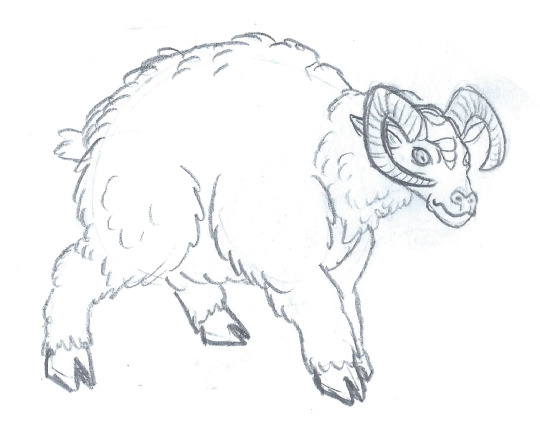
@toothlessloveshiccup‘s Argonox is the first - but far from the last - monster in this breakdown that brings in a bit of fantasy influence to ATOM’s roster. A golden-fleeced ram with a vicious streak, this sheep is both treasure and dragon at once. And while it wasn’t written in the monster’s profile, given the Yamaneon-rich nature of its wool, Argonox might be able to replicate the healing power of the golden fleece too! A very fun mammalian kaiju and excellent entry.
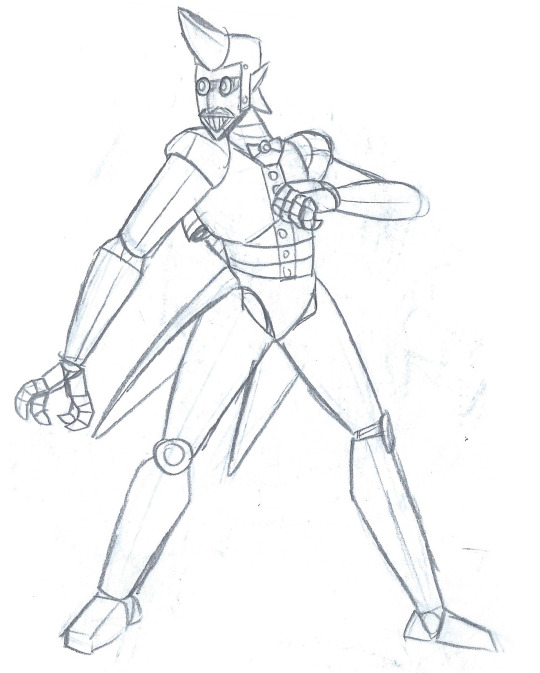
@highly-radioactive-nerd submitted Gunmetal Jeeves, a robot butler who can gigantomax temporarily create a holographic/hard light version of himself to fight kaiju. That detail was a late revision added to the entry before the contest’s deadline, made after the creator realized that ATOM allows for some truly ludicrous bullshit, which is something everyone should exploit when making entries for this in my opinion. Also, this is a robot butler who can size shift. Revel in its awesome absurdity!

Ultranerd submitted Rajasaurus, a dimetrodon-like synapsid kaiju with electric powers. His origin specifies that the electric powers are a result of the volatile nature of the Yamaneon deposits he mutated under, which is an interesting idea. That’s another theme that cropped up a lot in this contest’s entries, actually - people really wanted to play with what Yamaneon can do.
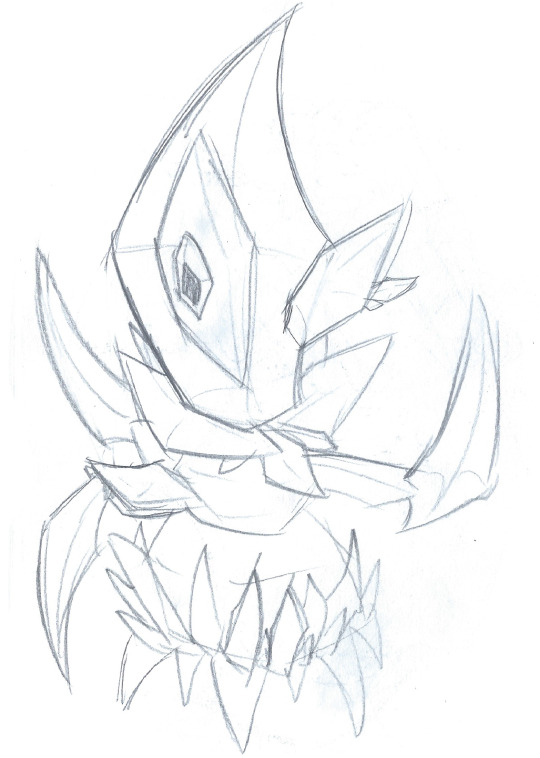
Case in point, @polygonfighter’s Yamaneolith takes the Monolith Monsters homage at the heart of Yamaneon even more apparent. I like the implication that there is a second mineral-based lifeform at the root of this Yamaneon cluster’s anomalous behavior - a parasite, perhaps? It brings up some interesting possibilities.
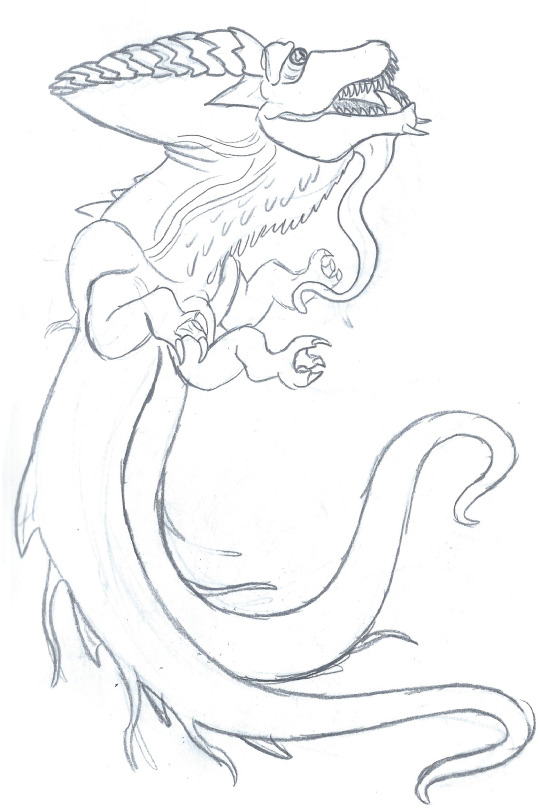
@ariccio50 submitted Kukulkuzana, and damn is this a cool spin on the body plan of my martians. I made a few changes here and there (splitting its tail into two is probably the biggest one), but tried to keep true to the original design, because holy hell is it gorgeous. The idea that this is a mountain-dwelling creature is really intriguing to me, as it looks like a sea creature, but at the same time, that flexible and low-slung build WOULD work pretty well in mountains, and it’s just the right mix of plausible weirdness that makes for a fun alien design.
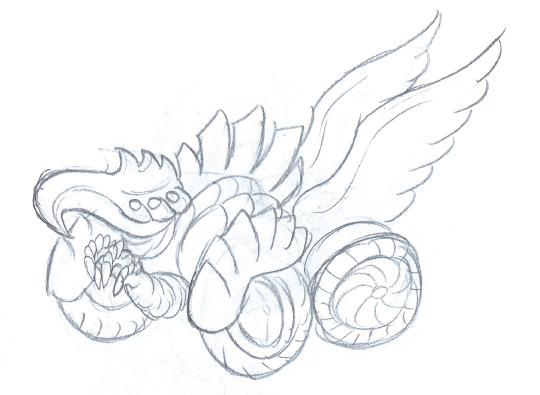
@akitymh submitted Aramzados, a Venusian monster that’s basically an organic hot rod car. I like the idea of organic machinery being the gimmick for Venusian kaiju, and Aramzado’s does it subtly enough to not feel like that gimmick is the sole thing going for it. I especially love this monster’s stange, apparently mouth-less blade-beaked face.


@virovac submitted Rurzar and Zar Rider, a Beyonder kaiju and mecha (respecitvely) that were both modified and repurposed by humans reverse engineering Beyonder technology to make, like, a motorcycle-saurus essentially. It is a delightfully absurd concept, and a very, very detailed one (13 pages of description). There’s a dark undercurrent beneath the sillyness, though, as this pair show that humanity might still be following the same path as the Beyonders before them.

@dinosaurana brings us Krangor, a humanoid monstrosity of living kelp! The goal here was to create a Jack Kirby-esque monster dude, complete with the gibberish name and all. He’s also made out of kelp, which feels very classic 1950′s monster-y despite me not being able to think of any monsters that were explicitly made of kelp. I love him.

@kiryuthechimera submitted Genkakurah, a psychic retrosaur with some draconic features. Though his substantial powerset is probably the biggest distinguishing feature of this kaiju (given that most ATOM kaiju pretty much have the same standard powers), what really draws me to him is that reptilian pseudo-beard. It’s just a fun detail!

@glarnboudin submits Tiratola, and see, there’s that fantasy influence again! Even more explicitly dragon-y than Kraydi, Tiratola still manages to toe the line between sci-fi and fantasy enough to fit ATOM as is while still cementing its ties to my own slice of fantasy fiction. Man it’s good I’m doing a Midgaheim book next, huh?
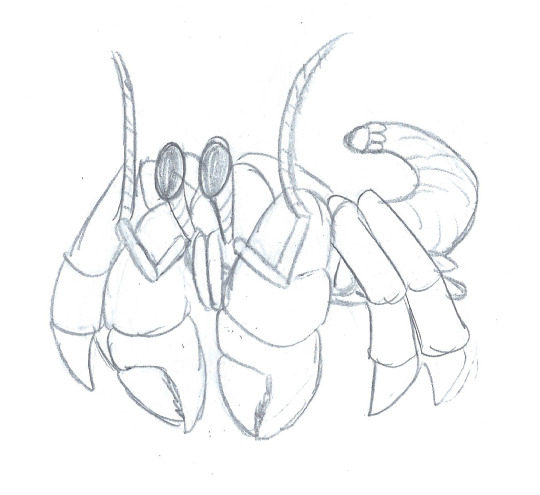

@dragonzzilla submitted Scuttlebutt/Argonautilus, a hermit crab kaiju who lives in/with a hollowed out mecha. That’s a twist I can’t recall ever hearing before, and the idea of a kaiju and a mecha having an equal partnership that doesn’t involve one being grafted to the other is really intriguing to me. A very unique concept!

@evolutionsvoid submitted Fleagor, an enormous flea who has no idea what to do with itself now that there’s no creature large enough for it to parasitize. I love that concept - it takes the core idea of the giant bug kaiju archetype (i.e. unsettling the audience by showing how terrifying small, “insignificant” creatures would be if our sizes were reversed) and really turns it on its head. The name also plays on the Universal Monsters, who were a huge part of 1950′s pop culture thanks to their movies being re-released in that era, so all and all this one is very on brand for ATOM!
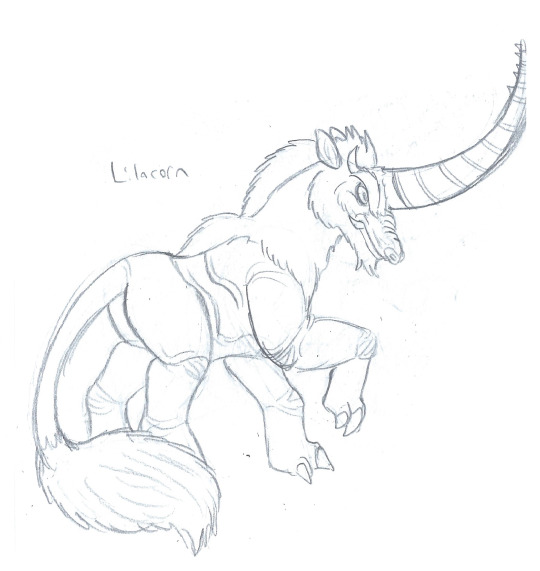
@skarmorysilver submitted Lilacorn, another entry that plays up that Midgaheim/ATOM connection. Reinterpreting the mythological unicorn as an Cenozoic wooly rhinoceros-inspired monster gives it a very unique look, both in ATOM and in the general world of unicorns, and she has a bad-girl with a heart of gold personality to boot!

dracosaurus-rex submitted Florasaura, a two-headed plant/retrosaur hybrid monster. I love me some plant monsters, I love me some retrosaurs, and I love me some rhyming the word “flora” with other words that contain similar vowell sounds, so this one has me written all over it!

@downtofragglerock submitted Sauroguana, a delightfully odd flying retrosaur. There’s a great deal of charm to the original illustration that this sketch doesn’t quite capture - it’s a deceptively simple design with a lot of personality in it, and with those unique leg-wings it really doesn’t need a whole lot of frills to stand out.

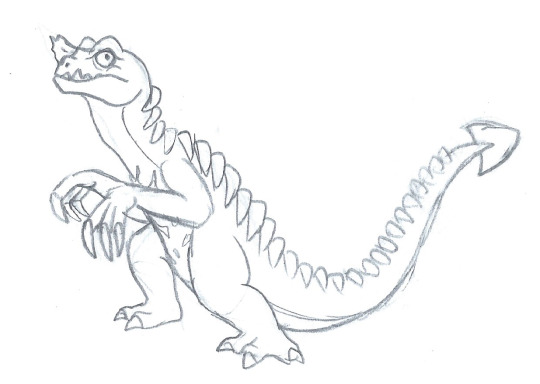
Draxi submitted Brakan, an unimpressive burrowing retrosaur kaiju whose mastery of illusions allows it to convince other kaiju it’s actually a big, super-powerful badass that’s the ultimate fighter in the universe. It’s a delightful parody of the concept of a fan self-insert god-mode character, with a really fun story built into it to boot!
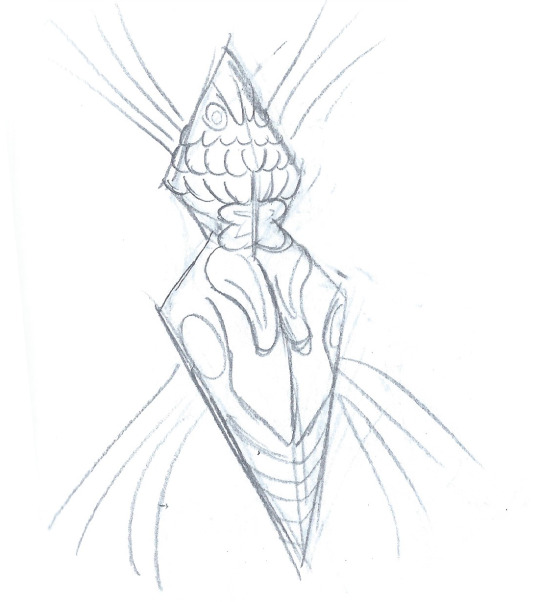
@quinnred submitted O.N.I.A.C., a mysterious cocooned kaiju whose chrysalis has been turned into an organic computer of sorts by the people studying it, and seems to possess a fairly advanced intelligence for a kaiju. It’s a really bizarre and ominous idea, with built in intrigue given how vague its nature is. Is it just a kaijufied butterfly/moth who got stuck mid transformation? A relative of the Mothmanuds? Something else, perhaps equally alien? Good story potential here.

shadyserpent submitted Vespilitor, a bat/retrosaur hybrid made by the nefarious Spooks Organization. A mercurial prankster whose tendency to stir up trouble never crosses the line into maliciousness, he’s the kind of monster who would make a great foil to a lot of ATOM’s cast. I’d especially like to see him in a prank off with Ahuul - it’d be like Bugs Bunny fighting Daffy Duck, but on a kaiju scale.

@multiversefan submitted the Yamaneon King, a nomadic kaiju whose refusal to settle down causes problems as he stirs up trouble at kaiju sanctuaries all over the globe by showing up unannounced and stirring up the locals. He was basically designed to be a monster that the kaiju sanctuary initiative would struggle to deal with, which is a good idea for a post-ATOM Volume 2 story conflict.

Sir K submitted Jadeera, a kirin kaiju that can actually forcibly convert most of its body to Yamaneon to enter a dormant, statue-like state in a loose homage to King Shisa. Though the fantasy elements are far more present than I usually prefer for ATOM kaiju, I think it should be noted they’re pushed that far for a purpose - a theme in Jadeera’s entry, which continues where its creator left off with their submission to the previous ATOM create a kaiju contest (Yokaigon), is that the world of kaiju is more complicated and challenging than many are willing to accept, which is a theme in ATOM itself. Yokaigon’s more supernatural/occult powers are based on the ghost parascience of my setting, which ATOM has delved into a bit (Pathogen being the big example), so it’s not as out of left field as some might think.
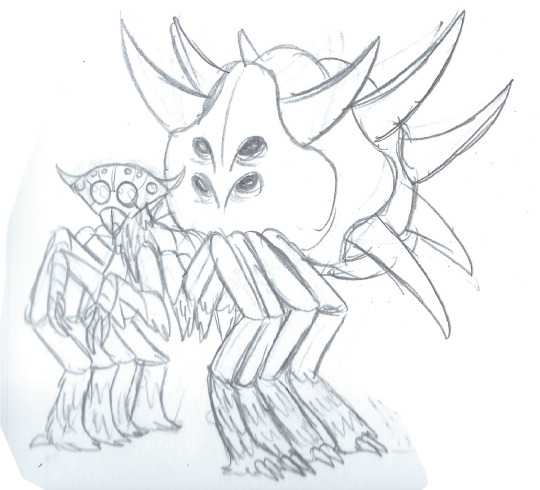
@cerothenull brings us our final entry (unless some got lost thanks to tumblr’s shitty tagging system), the flying spider Naeranti. She’s a kaiju spider who uses silk to make complicate hot-air balloons, more or less, and that’s just delightful. ATOM could always use more spider-monsters, and with a really unique gimmick backing up a wonderfully distinct look, Naeranti is sure to stand out among her fellow giant arachnids.
Well, that’s the roundup! In a week (or two, depending on how much my hand cramps) we’ll have the five finalists, and sometime after that, the grand prize winner!
55 notes
·
View notes
Text
The Case for Dark Sun
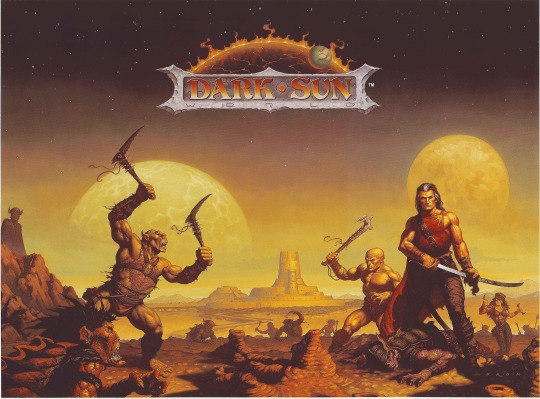
Dark Sun is a campaign setting for the Dungeons and Dragons Roleplaying game beginning with 2E in 1991. Dark Sun sits amongst other settings such as The forgotten Realms, Eberron, Planescape, Spelljammer, and Greyhawk as a world or universe in which D&D campaigns might be set.
The world of Dark Sun, called Athas, is a world where magic has ravaged the landscape, turning it into a barren desert dotted here and there by oppressive city-states. It deviated in many ways from both its contemporary settings and from epic fantasy as a whole and remains a beloved world for many. This break from the typical canon of D&D included things such as magic being rare and despised, many of the familiar races being changed or absent in the setting, and an emphasis on day to day survival over lofty goals of heroics or righteousness. We see evil Sorcerer-Kings ruling over an oppressed and enslaved populace in lavish, cruel cities. We see nomadic tribes wandering through a harsh wasteland filled with bizarre and vicious monsters, searching for water and shelter. We see ruins in the desert, symbols of a bygone age of peace and prosperity, destroyed long ago by wars and reckless sorcery. This setting represents a synthesis of design, visuals, mechanics, and themes that is unmatched by few if any other campaign settings for D&D. For these and reasons I will go into further, Dark Sun is the best campaign setting either TSR or Wizards of the Coast have ever produced.

Dark Sun came out of a period of D&D’s history where TSR were furiously producing campaign settings left, right, and centre. This period, 2E, lasted from 1989 to 1996, at which point TSR went bankrupt and sold D&D to Wizards of the Coast, of Magic the Gathering fame. During this period they produced such settings as Spelljammer, Dark Sun, Planescape, and Birthright, all of which pushed the boundaries of D&D in some way beyond the older heroic fantasy of Dragonlance, Forgotten Realms, and Greyhawk. Many of these new settings were only modest successes, and TSR’s dilution of their brand with all of these conflicting products likely had a part in their downfall. However, before they fell they gave us intriguing, genre-bending, and in many ways inimitable campaign settings. Dark Sun is the best of these and as such has a large fan community to this day and has received some degree of support in both 3.5 and 4E.
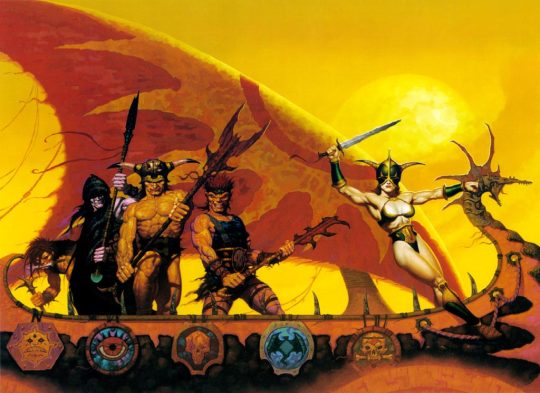
Dark Sun was developed by Timothy B. Brown and Troy Denning and draws on the typical pulp-fantasy sources of D&D, like Conan the Barbarian, Fafhrd and the Gray Mouser, and to an extent, Moorcock’s Eternal Champions books. However it also draws on things such as Frank Herbert’s Dune, Edgar Rice Burrough’s Barsoom series, incorporating Sci-Fi elements just as Spelljammer did. In terms of genre, Dark Sun might be described as belonging to Post-Apocalyptic, Dying Earth, Swords and Sorcery, Dark Fantasy, and even Science-Fiction. Gone are the mystical forests, noble knights, and sagacious wizards of almost every other campaign setting. In their place are hulking barbarians, callous rogues, desperate gladiators, and despised sorcerers practicing their arts in secret. With these concepts in place, the world of Athas is populated by cities and cultures inspired by a variety of peoples and empires from earth’s past. The Aztecs, Ptolemaic Egypt, and Hammurabi’s Babylon to name just a few. This helps to cement Athas as being more akin to the Asia and Northern Africa of antiquity rather than the nauseatingly familiar medieval Europe we’ve come to expect from D&D.
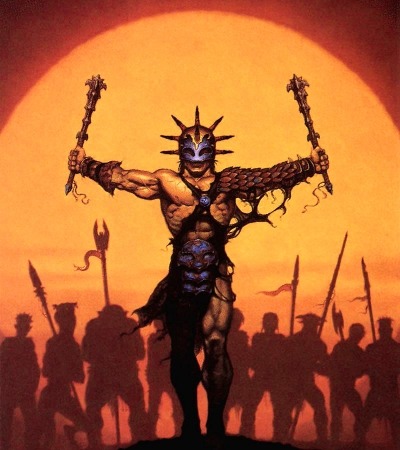
Dark Sun is notable for its pulp adventure art direction, spearheaded by Brom whose artwork can be found everywhere. A young artist at the time, his work inspired many of the monsters and creatures that appear in Dark Sun sourcebooks. While it is by no means unusual to see Dungeons and Dragons products accompanied by amazing artwork, Dark Sun stands out for the clarity of its vision. The pieces share similar designs and its products are easily identified at a glance. Brom’s work sets the product line well apart from anything else before or after. This ‘art-inspired’ design would never again be matched by any Dungeons and Dragons product, with only the Planescape line coming close.
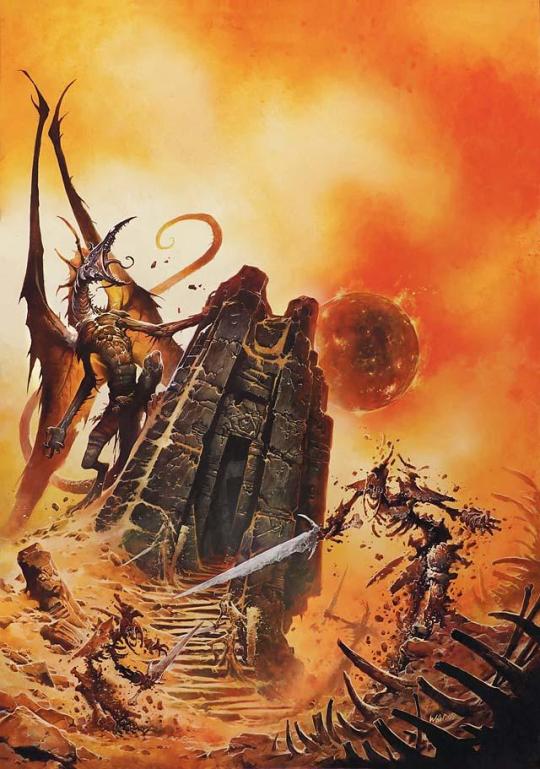
The history and truth behind Athas’ present ruined state is kept deliberately unclear by both the designers and powerful figures within the world itself. This leaves multiple interpretations of canon (at least in the original boxed set). Essentially, Athas has gone through at least three ages, typically referred to as the Blue Age, the Green Age, and the present Desert Age. The Blue Age was a world ruled by Halflings who lived on small islands amidst a vast ocean. These halflings had a great degree of control over nature and could grow almost everything they needed, making them masters of bioengineering. The Green Age was the period of Athasian history most resembling the standards of settings such as Forgotten Realms, Greyhawk, and Eberron, but leaned more heavily on Psionics than magic in its varied and verdant cultures. The Desert Age is the standard time of play and is a world controlled by a vengeful environment and the whims of tyrannical sorcerers. This final age is the one expected in typical play in the Dark Sun setting and is the world presented in most if not all the art and stories of the various Dark Sun product lines.

Like all good stories and worlds, Dark Sun has important messages built into it. These messages are evident everywhere in the world and its characters. Like Dune before it, Dark Sun has strong and deeply ingrained environmentalist messages. The world was once vibrant and lush, filled with a variety of lifeforms. Now the world is drained of all material resources, the vast grasslands and forests are almost completely gone, and the sea vanished, leaving only silt behind. The animals that remain are twisted, violent mutants, and the scattered plant-life is little better. This environmental collapse was not an accident and has been, at each stage, the result of irresponsible and reckless magic-use on the part of a sorcerous or naturemaster elite. The unfortunates of the Desert Age are, for the most part, innocent in this environmental degradation and simply have to endure the ruined world they were born into. Most only have a vague understanding that ‘sorcerers did it’, not fully understanding that their rulers, the Sorcerer-Kings are responsible for almost all of it.
Their origins are left vague in the original boxed set, Troy Denning and future product releases make it clear that the Sorcerer-Kings are the cause of most of the world’s destruction. These immortal psionicist/wizards ruined the world and then divided up the last oases amongst themselves, ruling the people that flocked there. The Sorcerer-Kings and their Templar priests are cold tyrants who brook no threat to their authority and violently suppress rebellions or even attempts to learn the truth about them. Many of these tyrants claim to be gods or ‘responsible sorcerers’ and blame others for the destruction that they themselves wrought. With the modern spectre of climate change looming and our leaders refusing to act or take responsibility for it, Dark Sun is more relevant than ever.
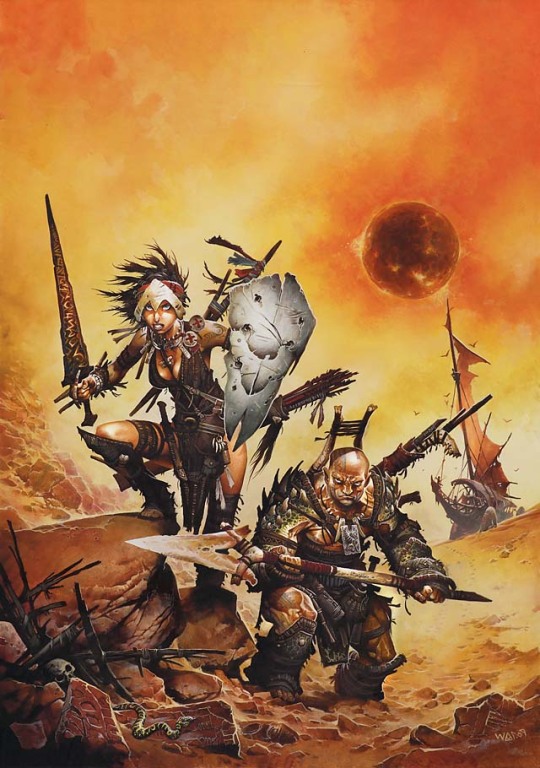
Dark Sun is infamous for tweaking, breaking, or outright removing typical elements of whichever D&D edition it exists in. Arcane magic draws life from the plants and even creatures around the caster, draining their vitality to fuel spells. Instead of magic being common and widespread it is rare and feared, in its place stands psionics; the Will and the Way. Due to the scarcity of metals such as iron and bronze, armour and weapons are typically made of salvaged components such as obsidian, stone, bone, or chitin. Dark Sun has a very minimalist cosmology compared to most other campaign settings with only really the Elemental planes having any real impact on the daily lives of most Athasians. Athas can’t be accessed from other worlds and there is no Heaven for Athasians’souls to go to after death.
Many of the recognisable races such as gnomes, orcs, and goblins are gone, replaced by strange new races like the half-dwarf Muls, the unnatural Half-Giants and the insectoid Thri-Kreen. Existing races are tweaked in large and small ways; Halflings are cannibals, elves care nothing for nature, and dwarves are completely hairless. All of this means that the typical adventuring party looks very different to what you might expect in other worlds. Instead of magic they employ psychic powers, instead of gleaming armour they wear ramshackle insect-shells, and instead of magic weapons they have obsidian axes. survival is more important than glory and clean water is worth more than all the gold in the world.
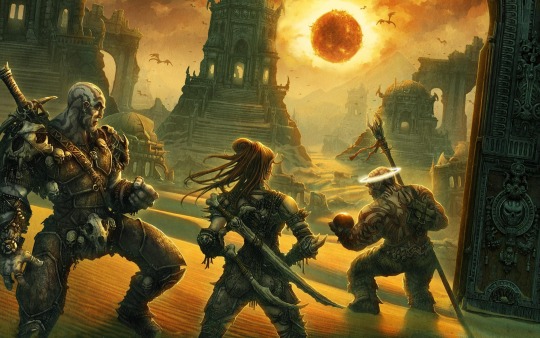
Psionicists use their mind to conjure strange effects, to control others, and to fight, and are everywhere. The plants and animals of Athas are almost all psychically sensitive in one way or another and this is in part due to the timing of the Complete Psionics Handbook’s publication aligning so closely with the Dark Sun product line’s beginning. As such, this focus on psychic rather than magic ability suffuses the setting and informs what kinds of characters exist there. Spell components are illicit and hard to come by, but any living person can focus their mind to create a psychic effect of some kind. Psionics has had a troubled time throughout DnD’s long history, having difficulty differentiating itself from magic and facing balancing and theming issues aplenty. Nonetheless, psionics is an engaging and essential part of the setting and any interpretation of Athas without it would be hollow.

Dark Sun doesn’t cater to the lowest common denominator by adhering to the heroic and epic fantasy of its contemporaries. It also sets itself apart by striving for uniqueness and pushing the boundaries of what people expect from a Dungeons and Dragons setting. It can be a difficult world to play in and exist in, what with its strange aesthetics and stranger rules.
However, its combination of groundbreaking world design, powerful artistic direction, and compelling lore make it a classic, and in my opinion, the greatest campaign setting ever produced by Wizards of the Coast or TSR.
#Dark Sun#Athas#Dungeons and Dragons#D&D#DnD#wizards of the coast#art#rant#Tyler Jacobson#wayne reynolds#william o'connor#Gerald Brom#Brom#Kerem Beyit
79 notes
·
View notes
Text
matchup commission!
i hope this isn’t too much!! i’ve tried to break it up to make it more readable, but let me know if there’s anything i can do!!
game: either Three Houses or Awakening, tbh! unless there’s, say, a character from Echoes that fits better? just pick who you think is best <3
pronouns: she/her gender preference: I don’t mind!!
personality
the good:
curious
i love to learn? is that a good thing?
open-minded
thoughtful
communicative
good conversationalist (or, at least I’d like to think so)
good listener (i’ll happily sit with someone as they talk about their day, or they want to complain about something, or if they just need someone to talk to in order to flesh out their ideas/beliefs!)
trustworthy (ish)
compassionate (or at least, I try to be!!)
patient
accepting (within reason aadjsdfkjhfds essentially i just try to not judge people)
understanding (I do my very best!!)
the bad:
prone to catastrophizing (that’s the anxiety poking through)
indecisive (I cannot make a decision to save my life)
shy (it’s not that I’m quiet or withdrawn, I’m just Deeply Afraid Of Rejection)
unforgiving (while I can be pretty patient, once I’m done with someone, I’m Done)
prone to melancholy (I do my best to fight it, but that melancholy be Strong)
overthinker (i literally write a whole dissertation in my head about a topic literally No One cares about… or i’ll decide to pick apart my relationships with others when it’s really not that deep. this one’s a mixed bag.)
the neutral:
opinionated (I’m putting it as a neutral trait bc I’ve been told that I’m “interesting to talk to” because of it, but my god… sometimes I wish I’d just calm down)
sensitive
talkative (for similar reasons as opinionated… I love to talk and I have So Much to say, but sometimes I wish I’d just learn to… shut my damn mouth)
my sense of humour (i’d describe myself as a “chaos goblin”, and one of my friends once said I’m a “mixed bag of human”, meaning that he can never predict what I’m going to say to him next; essentially i have a very “flexible” sense of humour, but the more absurd, the better)
perceptive (neutral just bc while it’s good when dealing with people I like, it’s fuel for anxiety)
interests:
reading (when I can actually commit to a book sjkdfhs)
if it’s of any consequence, my favourite books are probably the prophet by kahlil gibran and neverwhere by neil gaiman
writing (when I’m not LAZY!! Also, my genres tend to be more along fantasy or urban fantasy lines? A little sci-fi, when I’m not scared off by trying to do worldbuilding for that genre because O H B O Y science & technology is a LOT scarier than magic tbh)
trawling Wikipedia for an unreasonably long time
drawing
anthropology (it’s my uni major and I love it!! so much!!)
history (i’m a whole-ass nerd)
art history (I LOVE ART, my fave artist is probably alphonse mucha? If you’ve never seen his stuff definitely have a look! It’s A Lot but it’s stunning)
sociolinguistics (it’s so interesting!! And I guess languages too, but I’m so bad at learning them asjfdhddsklj)
fashion (in a way? I just love pretty clothes, and my style is… a lot of patterns, especially animals and flowers, and it’s retro-adjacent?)
D O G S
most animals tbh (I love foxes and owls! but i instinctively don’t trust horses)
for the pokemon matchup…
i tend to prefer pokemon that are based off real animals, more so than those like… objects? although I wouldn’t rule objects out, that’s just on the whole
i’d be looking for a companion more than a battling partner, if you know what I mean? So general temperament would be more important than battle prowess
neither this way or that on how powerful the pokemon would be, but I’d like it to be strong enough to defend us should the need arise?
i tend to prefer elegant pokemon to cuter ones, but this isn’t a deal breaker
basically I just want a Friend TM
i also like pokemon with mythological inspirations!! not necessarily legendaries or anything like that, but i think that’s fun
i usually pick water starters, and my favourite types would probably be… dragon, ice and probably dark or psychic? But All Pokemon Are Valid
______________________________________________________________
My goodness, you certainly gave me a lot to work with, but I know just who I want to pair you with because of it!
It didn’t take me long to realize you and Ashe would be a good fit for one another; many of your interests are the same or similar but the two of you are also different enough to keep things lively and interesting in a relationship!
The two of you probably met in the Monastery's Libary; it’s a little cliche, but the two of you were reaching for the same book at the same time and your hands touched. Ashe, of course, retracted his hand immediately and blushed before even seeing your face; seeing how cute you were only made it worse for him. However, you’re just as shy and probably hid your face so he couldn’t see your blush. It was all very cute and before you could apologize, Ashe was handing the book to you. “It’s one of my favorites,” he had laughed, placing it in your open hands “I’ve read it before, so you can have it.”
From then on, he was in deep; Ashe couldn’t help but recommend more of his favorite books to you and even went out of his way to read things that interested you so he could have more of an excuse to talk to you. It was obvious to anyone that saw the two of you together that you liked one another but since the two of you were both the wonderful combination of shy and awkward, it took far longer than it should have for the two of you to get together.
But the two of you get along so well together, people wonder how you ever functioned without one another. Ashe’s want to help others paired with your compassion makes you quite the duo and the two of you became known for helping others however you could. Behind closed doors, the two of you are a very sweet, affectionate couple, reading to one another, indulging in the others oversharing about their hobbies/interests (just the way Ashe’s eyes light up as he talks about true chivalry is enough to pick up your heart rate) or taking some time just to soak in the others company.
I truly think the two of you complement one another in a great way, where your strengths are similar enough to work in tandem but you also cover one another's weaknesses (Ashe is forgiving in situations where it might be better but other times you know when to draw the line). I really think you two would be so good for one another!

As for partner pokemon, I can’t help but feel Absol would be a good fit! It’s got a basic animal shape while still being very much based in mythology, especially if you mega evolve it! While they’re said to be harbingers of misfortune, the truth is Absol actually forwarns of danger (kinda like Mothman in that sense?). And surely it will be strong enough to defend you but content enough just to spend ifs time with you protecting you only if the need arises.
Another thing, I like to think that Absol’s will only stay with trainers they find are caring and compassionate; so long that you show Absol you’re worthy of its service (so, just keep being a dear and being helpful and kind to those you meet) I’m sure the two of you will get along perfectly!
Can’t you just imagine it? Your Special Dark Puppy Creature curled up by your feet as you read or write, ready to help at a moments notice! Oh, and I just saw above how you love dogs so... isn’t it great that I choose Absol?
Funny thing about this gif I was actually considering Umberon before I remembered Absol hehe

4 notes
·
View notes
Text
Gay Sci-fi Recs
I've complained enough recently that I figure I should balance it out. And I think a small subgenre like sci-fi gay romance deserves some pimping. So these are the ones that I've found so far, minus the great work by Santino Hassell, which has sadly been pulled from Amazon. It's probably still findable online, though, so I'll still encourage anyone to seek out his work if you're interested in very well-written and realistic, often gritty but ultimately sweet gay genre romance.
Angel Martinez, 'Gravitational Attraction'
In some ways, Gravitational Attraction is the closest m/m novel on this list to more mainstream examples of vaguely cyberpunky space opera romance, which I have long enjoyed, ever since my teenage affection for Joan D. Vinge. There's spaceship battles, fascinating alien societies, two tortured heroes, a cyborg, and strange but dramatic powers with scientific sounding yet outlandish explanations. In this case, you'd probably call both protagonists 'tortured heroes', which is cool, not to mention one of them is the cyborg (of sorts). I love the way the story starts out with a bang, as a small commercial ship encounters the creepy remains of an inexplicable catastrophe in space, with a sole survivor who doesn't remember what happened. Things keep going in a fast clip from there, even as a sweet relationship develops between two almost broken but ultimately very strong individuals. It's a very satisfying story even just for sci-fi fans, but if you're into both queer romance and genre fiction, you'll be very pleased.
Felicia Davin, 'Edge of Nowhere'
This is a wonderful, now somewhat classic cyberpunk concept: the teleporting brash young runner, Kit, hired by the shady corporation that's engaging in shadier research that messes with the nature of reality. Kit is far from a cliche, however: he's extremely vivid and sympathetic, and he's a great match with the steady, protective and honest guard Emil, whom Kit is hired to transport. But of course, things go wrong and nothing goes according to plan. There's a bunch of interesting physics ideas being played with, but there's equally interesting relationship dynamics, both between Kit and Emil and between Emil and the other corporate employees he feels responsible for. It's rare that the 'shady corporation' is presented in a complex way that includes the manifold motivations and natures of the various scientists and human beings actually working there. There's a wonderful subtlety to all the relationships, not just the romance, and the writing overall. It's very satisfying both as sci-fi and as romance, which is rare and definitely something to celebrate.
Hanna Dare, 'Machine Metal Magic'
I definitely enjoyed the fun, breezy writing here, and I like the premise of techno-psychics enough to overlook some of the holes in the world-building. Perhaps I simply have some issues with the idea that the Singularity occurs and all machines could rise up to the point where they exile all humanity from the solar system. If you swallow that basic premise, however, there's fun to be had, and the book is stand-alone but first in an interesting series. The romance is on the cute and sweet side, without much interpersonal conflict, but the psychic, Jaime, is a very good match with the more steady, jock-type Rylan. It helps that Rylan has secrets of his own, and the other people on their ship have fun personalities with some mystery as well. The overall plot here is fun, especially since I really enjoy the whole AI aspect, especially an AI that can only really talk to (or through) one person. It's not super memorable but still a fun read.
Jenn Burke and Kelly Jensen, Chaos Station series
I absolutely love this series about two super gritty, abrasive soldiers, best friends and former lovers, both of whom thought the other was presumed dead in a human-alien conflict. The story starts as a retired soldier, named Zander, needs passage on a ship that the other's coincidentally working as a mechanic on. Zander is a super soldier on a mission to rescue his fellow altered comrade who had seemingly gone violently insane as a consequence of the procedure, initially done to help fight the aliens. Now Zander too is in imminent danger, and he needs his old lover, Felix, and his crew to help him save his comrades from themselves. Not to mention the danger that Zander is in, on a race against time as he fights not to succumb to violent insanity before he's done or they find a solution. Needless to say, the challenges here are truly impressive, and the action is fast-paced and exhilarating, though the thing I really find outstanding is the gritty, believable atmosphere of life on a spaceship or a space station, as well as the abrasive but intense and deeply loyal, ultimately loving connection between Felix and Zander. Especially in the later installments, there are also several scenes where truly strange and awesome things occur, enough to inspire that famous sense of wonder that is supposed to result from the best science fiction.
Kelly Jensen, 'To See the Sun'
This is more of a gay version of a mail-order bride story, where instead of the American West, you have a rim planet. It's a small scale, almost slice-of-life romance story that depends on the gritty, believable details of world building about an outpost on a mining planet for its science fiction aspects. If you like survivalist sci-fi, such as The Martian (which I do), combined with careful and sensitive characterization, plus a kid that adds to the story instead of being window-dressing, you'll enjoy this. I wouldn't have tried this without enjoying the Chaos Station series, but I'm glad I did. It's not the grand space opera or thriller I normally gravitate towards, but these are interesting and real-feeling people that I cared about, which is what's really important to me.
8 notes
·
View notes
Text
Evil in the Mirror: John Carpenter’s Revealing ‘Prince of Darkness’ by Joshua Rothkopf

[Last year, Musings paid homage to Produced and Abandoned: The Best Films You’ve Never Seen, a review anthology from the National Society of Film Critics that championed studio orphans from the ‘70s and ‘80s. In the days before the Internet, young cinephiles like myself relied on reference books and anthologies to lead us to films we might not have discovered otherwise. Released in 1990, Produced and Abandoned was a foundational piece of work, introducing me to such wonders as Cutter’s Way, Lost in America, High Tide, Choose Me, Housekeeping, and Fat City. (You can find the full list of entries here.) Our first round of Produced and Abandoned essays included Angelica Jade Bastién on By the Sea, Mike D’Angelo on The Counselor, Judy Berman on Velvet Goldmine, and Keith Phipps on O.C. and Stiggs. Over the next four weeks, Musings will continue with another round of essays about tarnished gems, in the hope they’ll get a second look. Or, more likely, a first. —Scott Tobias, editor.]
It’s generally accepted that John Carpenter wasn’t a personal filmmaker—not personal in the way that Martin Scorsese, only five years his senior and Italianamerican from the start, was. Carpenter grew up movie-crazy in the ’50s and ’60s. He wanted to make Westerns exactly at the moment when that became an unrealistic career goal. His heroes were Alfred Hitchcock, Orson Welles and, above all, Howard Hawks. It’s been nourishing to listen to Amy Nicholson’s wonderful eight-part podcast Halloween Unmasked, still in progress, and to hear Carpenter—usually oblique in interviews—open up about his boyhood in the Jim Crow–era South. He mentions visiting an insane asylum during a college psych trip and locking eyes with a prisoner who spooked him. That may be the basis for killer Michael Myers but, by and large, this was a guy who wrote what he dreamed up, not what he knew.
That’s not to suggest Carpenter didn’t develop his own signature style. When he arrived in Los Angeles in 1968 to attend film school at USC, he reinvented himself, transforming from a Max Fischer–like creative wunderkind (he was a rock guitarist and high-school class president) into a laconic, bell-bottomed cowboy who listened more than he spoke. He was too cool for nerdy Dan O’Bannon, who worked with him on Dark Star. He was too cool for Hollywood itself, even after he’d succeeded there, rarely mingling socially and turning down projects like Top Gun and Fatal Attraction.
But the cool act was a bit of smokescreen. I once asked Carpenter about it, and he owned up to a private sense of pain in regard to his work. “I take every failure hard,” he told me in 2008, singling out the audience’s abandonment of The Thing, a remake of his favorite film (one that actually improves on its source). “The movie was hated. Even by science-fiction fans. They thought that I had betrayed some kind of trust, and the piling on was insane. Even the original movie's director, Christian Nyby, was dissing me.”

Carpenter would rebound from that 1982 commercial disaster—as well the indignity of getting sacked from Firestarter—by playing the game even better. He directed Jeff Bridges to a Best Actor nomination on Starman (that’s as rare as a unicorn for a sci-fi performance) and, just as things were turning golden, blew all his capital again on 1986’s Big Trouble in Little China, which was rushed and subsequently buried in the massive shadow of Aliens. “You try to make a studio picture your own, but in the end, it’s their film,” Carpenter said in our interview, the Kentucky rascal turned bitter. “And they’re going to get what they want. After that experience, I had to stop playing for the studios for a while and go independent again.”
This is the pivotal moment in Carpenter’s career, the one that fascinates me the most. It should fascinate more people, given what the filmmaker did. Divorced and with a two-year-old son, Carpenter is, at that point, 38 years old. He’s already feeling like a Hollywood burnout, with a decade of ups and downs to prove it. The solution was a pay cut, a big one: Prince of Darkness, financed through “supermensch” Shep Gordon and Alive Films and released in 1987, would be made for a grand total of $3 million, the first title in a multi-picture deal that guaranteed Carpenter complete creative control.

Scrappy but never chintzy, Prince of Darkness is the most lovable of movies. On the surface, it has all the cool minimalism a JC fan could ask for: elegant anamorphic compositions (Gary Kibbe’s muscular cinematography adds millions more in production value), a seesawing synth score, a one-location “siege” structure akin to the director’s Assault on Precinct 13 and The Thing. The movie also has Alice Cooper killing a grad student with a bicycle. It has a swirling canister of green Satanic goo in a church basement.
Critics, by and large, were unkind. In a representative review from the New York Times, Vincent Canby called it “surprisingly cheesy,” singling out first-time screenwriter Martin Quatermass for particular scorn (he “overloads the dialogue with scientific references and is stingy with the surprises”), not realizing that this was a pseudonym for Carpenter himself. Would it have mattered? Released days before Halloween, Prince got clobbered by the gig Carpenter turned down, Fatal Attraction, still surging in its sixth weekend.
But below the surface—and still a matter for wider appreciation—is the film that Carpenter dug himself out of his psychic hellhole to make: his most personal horror movie, starring a version of himself. Prince of Darkness is about watching and waiting. In a way, it’s a romantic view of the auteur’s own time at school. It’s a movie about the evil that stares out of the mirror (i.e., yourself). Like all of his films, it arrived under the possessive title John Carpenter’s Prince of Darkness. In my mind, that apostrophe is actually a contraction: John Carpenter Is Prince of Darkness. And Prince of Darkness is him.

First, let’s understand what $3 million means in 1987. To compare it to some other movies of the same period, Blue Velvet’s budget is twice as large. Hannah and Her Sisters, largely shot in Mia Farrow’s apartment, was funded at $6.4 million. When Scorsese decided to go indie and make his audacious The Last Temptation of Christ, he had a $7 million allowance—and that’s for robes and sandals. Carpenter, on the other hand, would be doing practical special effects in camera. He’d be doing a movie with gore and supernatural nuttiness. In a now-quaint New York Times article from April 1987 titled “Independents Making It Big” (“The major studios have abandoned small, serious, risky films, the kind that often win prizes”), Merchant Ivory’s Oscar-winning A Room With A View gets prime positioning with a big photograph; that one has a $3 million budget, roughly. (Not coincidentally, Carpenter’s financiers, Alive Films, are name-checked in the piece as the producers of Alan Rudolph’s Trouble in Mind.)
Coming off Big Trouble in Little China’s estimated $20 million budget (it was probably more), Carpenter would be making a radical shift. But he agreed to Alive’s terms. He’d return to doing things fast and smart, to distilling his vision down to its cleanest, clearest grammar, to getting it done in 30 days (Halloween was shot in 20, over four weeks in May 1978). Even if you disregard the whole of Prince of Darkness’s content—and we won’t be doing that—Carpenter’s desire to work in total artistic freedom is breathtaking. He will do what it takes to move forward.
A little plot: In Prince of Darkness, scientists, theologians and academics plunge into a dilapidated church where they power up their equipment and study a mysterious genie in a bottle: an “anti-god.” The scenario has some of the pseudo-tech fizz of Poltergeist or, in a lighter vein, the Harold Ramis scenes in Ghostbusters. It’s not meant to hold up under scrutiny. Carpenter, who says he was reading books about quantum uncertainty at the time (maybe not the most comforting bedside material given his professional predicament), gives pages of chewy dialogue to the twin father figures of his oeuvre: Donald Pleasence, returning from Halloween and Escape from New York, plays an unnamed, worried priest; and Big Trouble’s wizened Victor Wong appears as an esteemed professor of metaphysical causality.

If the movie has a conventional hero (it doesn’t), it’s Brian, a student who splits the difference between creepy and generically handsome. He’s played by Jameson Parker, then a TV star on Simon & Simon. Or at least I think it’s Jameson Parker. Unlike his more famous San Diego private detective, Brian sports a robust, porn-star-worthy moustache. It makes him look swarthy, mysterious—a little like the lanky John Carpenter himself, who shoots these early scenes in classrooms and hallways at his alma mater, USC. “I spent many happy years at SC as a film student,” Carpenter says on Shout! Factory’s collector’s Blu-ray. “I really enjoyed myself. I learned everything about how to make movies there.”
Watching Prince of Darkness is as close as we’ll come to seeing the director’s formative years re-enacted, memoir-style. In getting back to basics, Carpenter decided to do it literally. Brian sits in class listening; he has a bit of a Laurie Strode moment looking out the window, distracted. Who is he? He’s a young scientist observing evil, almost flirting with it. He spies on a pretty girl in the courtyard (Lisa Blount). She’s got a boyfriend and it irks him, wordlessly. Later, Brian will woo her to bed and use some hard-core Howard Hawks dialogue on her: “Who was he? The one that gave you such a high opinion of men?” he says, straight out of Lauren Bacall’s playbook in To Have and Have Not. It works. She kisses him.
The movie isn’t all wish-fulfillment. In fact, it’s charming how fully the Carpenter surrogate recedes into the team; Brian isn’t even a factor in the final showdown. Maybe his job is to watch other people vanquish evil. That would make sense, since it’s his creator’s comfort zone. In the meantime, the offscreen Carpenter is building some of his grossest sequences, spraying unsuspecting people in the mouth with streams of ectoplasm (à la Rob Bottin’s landmark FX in The Thing), mounting parallel action and deploying beetles, maggots and ants where necessary.
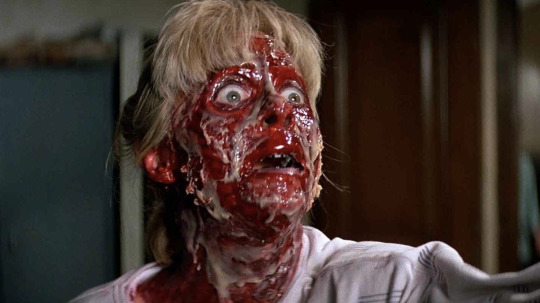
Prince of Darkness has one moment that’s proven unforgettable, transcending even the horror genre. It’s an eerie transmission, the voice slowed down and distorted: “This is not a dream…not a dream…” DJ Shadow samples it a few times on his groundbreaking debut, 1996’s Endtroducing. (The voice is actually Carpenter’s, impossible not to notice once you’ve been made aware of it.) He’s supposed to be a future dude reaching backward in time—“from the year one, nine, nine, nine”—maybe to prevent a biblical apocalypse. All we see is a jittery handheld shot of a silhouetted robed figure slowly emerging from the church, the ominous end-of-the-world smoke gathering.
The economy of the shot is beautiful, Carpenter achieving the texture of a half-remembered nightmare using only a capture-video-off-a-TV-screen trick. (It’s very Inland Empire—and come to think of it, that basement cylinder of swirling green evil is a lot like the glass box from the first episode of the rebooted Twin Peaks: The Return.) So in a situation where Carpenter is facing his most prohibitive spending limits, he’s actually expanding his craft. Prince of Darkness signals his own creative rehabilitation after turning his heel on the studios. Or, to quote the film’s poster: “It is evil. It is real. It is awakening.”
What does it mean that Carpenter’s big payoff involves a mirror? These Cocteau-like shots were some of the most dangerous to pull off. One of them involved plunging a prosthetic hand into highly toxic liquid mercury (a substance the crew had to drain from their hydraulic cranes just to make the gag work). Then, to capture the action on the “other side” of the mirror, poor Lisa Blount had to swim submerged in a darkened swimming pool while an underwater camera shot upward at the glimmering surface. I include these technical details not only to express awe at Carpenter’s commitment (along with that of his collaborators), but also to stress the obvious: The mirror climax was really important to him. The movie’s final seconds are the whole of Prince of Darkness’s reflexivity in a single cut: Brian, woken from a double dream, approaches his bedroom mirror. We see from the perspective of the glass. He touches that porn ’stache tentatively, then reaches out. Cut to black.
It’s not easy to touch that mirror—to walk away from everything you’ve labored to achieve over years, to a place where it’s just you and your talent and what you can do. To me, that’s what Prince of Darkness expresses, subtly. Creatively, the experiment worked: It led directly to Carpenter’s 1988 stealth masterpiece They Live, his most confident political statement and a kindred project in its use of real L.A. locations. That film’s critical reputation has already been defended at large. But maybe it’s time to rally behind the moment slightly earlier, when the director had to rediscover who he was, and what he wanted—and when he found a way to turn everything around.
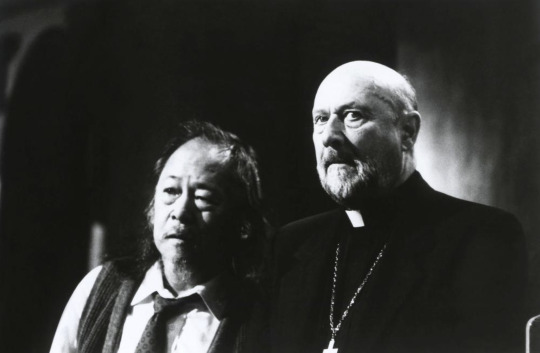
#john carpenter#halloween#prince of darkness#the thing#they live#horror film#produced and abandoned#demon#big trouble in little china#assault on precinct 13#joshua rothkopf#oscilloscope laboratories#o-scope labs#film writing#musings
6 notes
·
View notes
Text
Watchmen Episode 5 Easter Eggs Explained
https://ift.tt/2QsFTwo
Detective Looking Glass' origin story is revealed, and Adrian Veidt's plan becomes more clear in Watchmen episode 5.
facebook
twitter
tumblr
This episode contains Watchmen episode 5 spoilers.
About halfway through Watchmen episode 5 "Little Fear of Lightning," you should know that we've officially hit and surpassed the midpoint of the series. HBO's Watchmen only consists of nine episodes (not twelve), so it's time for the pieces to start falling into place and for some mysteries to be revealed. In this case, the mystery is why Wade Tillman/Det. Looking Glass is such an odd guy and why he behaves the way he does, while we also take giant steps towards untangling the mystery of Adrian Veidt/Ozymandias and whatever the Rorschach-influenced 7th Kavalry have been getting up to. If you spotted something I missed, let me know in the comments or hit me up on Twitter, and if it checks out, we'll get this updated.
Now, let's get to work. The clock is ticking...
HOBOKEN
- The episode opens in Hoboken, N.J. minutes before midnight on Nov. 1, 1985. You can hear a radio broadcast announce that the Doomsday Clock has been set to 1 minute to midnight, just as it was by this point in the book.
- Hoboken is located across the Hudson River from Manhattan and lines up almost exactly where the giant squid materialized, died, and detonated a psychic shockwave that killed millions. Hoboken’s proximity to Manhattan means it would be right in the path of that blastwave, just as residents of that city can often see and smell fires on the big island.
read more: Why Does it Rain Squid on HBO's Watchmen?
- Overall, this looks like a reasonable forgery of Hoboken in the 1980s, the buildings are all roughly the same height, and it feels like they’re roughly halfway up Washington St. As the camera pulls back from the carnage at the fair, you can spot Frank Sinatra Drive. Hoboken was the birthplace of Frank Sinatra, and his music features prominently throughout this episode.
- Hoboken was a haven for record shops back in the day, but I’m not sure if ZigZag Records ever existed there. However, the sign for that record shop here bears a strong resemblance to the defunct, departed, but beloved ZigZag Records that used to be located at Brooklyn...two rivers away.
- The pseudo-punks we see in Hoboken (and who terrorize poor young Wade) are the Knot-Tops subculture who featured in the book. One of them is wearing a shirt that says “katies” a reference to the street name for a drug called KT-28 which was used by many members of the gang. I guess they couldn’t get tickets to see Pale Horse at Madison Square Garden that night...not that it did them any good.
- You can spot a poster for the Pink Triangle benefit concert that was also hung on the side of the newsstand in the book.
- The bus that drops off the crew of young Jehovah’s Witnesses, including young Wade Tillman (the future Det. Looking Glass), is #486, but I’m having trouble finding any significance to that number or the numerals it consists of. Similarly there’s a license plate that reads BHS463, but I don’t see any greater significance there.
LOOKING GLASS
- As quickly becomes apparent, this episode is the origin story for Detective Looking Glass. That’s young Wade Tillman (played by Philip Labes) who gets humiliated in the funhouse hall of mirrors right before experiencing an excruciatingly traumatic psychic tragedy. It’s no wonder he’s a little bit off back in the present. His mask is more than just a convenient affectation, it’s made of something apparently called “reflectatine,” a material believed (probably just by crackpots) to protect from psychic blasts. It explains why we’ve seen him eating with his mask on at home. It’s also revealed that he lines his baseball cap with the stuff. It’s basically a “tinfoil hat.”
- Wade’s trauma has informed every aspect of his life, and keeps an alert system from a company called “Extra Dimensional Security.” Incidentally, the fact that they still deliver comprehensive print catalogs is another fun little reminder that the internet isn’t a thing in this world.
- Looking Glass is fond of eating cold baked beans right out of the can with his mask half rolled up, a habit he shares with Rorschach.
- Wade’s ex is named Cynthia Bennett, but she is an original creation for the show. Their relationship lasted seven years, and Wade makes the obvious mirror joke.
- Wade runs a support group for survivors dealing with trauma after the squid attack (there’s a pamphlet called EDA and You, presumably that stands for ExtraDimensional Anxiety). He greets new members by asking if they’re a “friend of Nemo.” Captain Nemo was a creation of seminal science fiction author Jules Verne and appeared in the novels 20,000 Leagues Under the Sea and The Mysterious Island. He was notorious for doing battle with giant squid.
- It sure seems like Wade is probably gonna be taking ye olde dirt nap after this episode, but we’ll have to wait to find out. But we do hear the ominous ticking of a clock during the part of the episode when he’s exploring the warehouse, and we last heard that in the leadup to Judd Crawford’s death. So it might be a tell that if you hear the clock ticking, someone’s gonna die.
- Is anyone able to make out the newspaper headline on the wall of Wade’s bunker? It seems like it has to do with 11/2 and Manhattan, but I can't quite nail the specifics of it.
ADRIAN VEIDT
- On the streets of Hoboken at the start of the episode you can spot someone reading a copy of Tales of the Black Freighter (presumably the same one the kid is reading all through the book), and on the back of it you can see an advertisement for “The Veidt Method.” The Veidt Method was a self-help program “for physical fitness and self-improvement” launched in the ‘80s by Adrian Veidt that was dedicated to “creating a new you” by combining mail away exercise, nutrition, and bodybuilding techniques with philosophy and new age thinking. The letter that greeted applicants contained Veidt’s “all best wishes and encouragement” sign off we heard him use in the letter to the Game Warden in episode three.
- As we see several times throughout the episode, Veidt’s philosophy about getting the world to believe there was a greater threat absolutely worked. It’s brought up in casual conversation, and you can see it in the philosophy espoused at the EDA support group, where they take the squid attack as proof that there are other dimensions.
- Veidt’s “confession” video was recorded on Nov. 1, 1985, minutes or hours before he unleashed the squid attack on New York City (and Hoboken). Redford was shown this video on Jan. 21, 1983, the day after his inauguration (which lines up with the day Bill Clinton was inaugurated in 1993 as well). HBO’s Peteypedia supplemental materials revealed that Veidt was also a major public player in the election of President Robert Redford, although the knowledge of his role in the squid attack never caught on publicly, despite the publication of Rorschach’s Journal.
- Within that video, Veidt refers to using “fear” as a weapon and says “and I am its architect.” This is more than a mere turn of phrase. “The Architects of Fear” was an episode of sci-fi anthology series The Outer Limits. It’s basic story? Scientists decide that the only way to prevent nuclear apocalypse is to convince humanity that we have a common enemy from another world and thus need to put aside our differences. Sound familiar? This story was the source of great friction between Watchmen series editor Len Wein and writer/co-creator Alan Moore, as Wein felt it was too similar to what Moore delivered in the book. The book, however, does reference the intro to The Outer Limits at one point, perhaps as Moore’s way of paying homage to the source.
read more - Watchmen: Jeremy Irons on the Mystery of Adrian Veidt and Ozymandias
Veidt also confesses that he has engineered “additional small scale extradimensional events” to keep up the illusion. In other words, the squid rain we first saw in episode one and that has been referenced throughout the series now has an official explanation.
- Veidt appears to be wearing the hieroglyph for the Eye of Horus on his makeshift spacesuit, a symbol of both protection and power.
- Is Veidt (and his prison) on a moon of Mars or Jupiter? While Mars is the obvious choice, there appears to be ice on the surface of that moon, and neither of Mars' moons (Phobos and Deimos) have them. On the other hand, two of Jupiter's moons, Io and Europa contain both oxygen and water in sufficient quantities that you could imagine Dr. Manhattan successfully synthesizing the environment necessary to create life. The music playing during his little lunar adventure is Claude De Bussy's "Clair de Lune."
- Veidt appears to write “Save Me” or “Save Me D” using the bodies of his servants. “Save Me Dr.” perhaps?
- The “memory pills” are called Nostalgia, which was also the name of a perfume line by Veidt in the 1980s. Are these a later creation by Trieu Industries rather than Veidt?
DR. MANHATTAN
If there’s any doubt lingering in your mind, it almost certainly appears that the bizarre environment Veidt has been imprisoned in is something of Dr. Manhattan’s creation. His outburst (and the Game Warden’s agreement) that “your god has abandoned you” would seem to be a reference to that. Specifically, right before he left Ozymandias (and our plane of existence, seemingly) in the book, Dr. Manhattan speculated on the possibility of creating life of his own.
RORSCHACH AND THE 7TH KAVALRY
- That giant red eye symbol we see painted on the wall of the warehouse that Wade explores will probably be significant later on, but it does also kind of resemble the squid eye in the book, doesn’t it?
- When Senator Joe Keene talks about being taken aside and shown a tape that reveals the truth about the world (in this case Adrian Veidt’s “confession” to President Redford), it feels like a bit that legendary comedian Bill Hicks used to do about the Kennedy assassination. OK, to be fair, Hicks did LOTS of bits about the Kennedy Assassination but this one from his Rant in E-Minor album is the most relevant…
“I have this feeling that whoever is elected president...when you win, you go into this smoke filled room with the 12 industrialist capitalist scumfucks who got you there. And you're in this smokey room, and this little film screen comes down ... and a big guy with a cigar goes, "Roll the film." And it's a shot of the Kennedy assassination from an angle you've never seen before ... that looks suspiciously like it's from the grassy knoll. And then the screen goes up and the lights come up, and they go to the new president, 'Any questions?' 'Uhhh...just what my agenda is.'"
- It would appear that Judd Crawford was legitimately involved with whatever nonsense was going on with 7th Kavalary based on his relationship with Joe Keene. But neither he nor Keene seem to actually be part of the 7th Kavalry nor their generally racist mission statement. But also note that we learned from HBO’s supplemental materials that the painting in the Crawford home was actually gifted to Judd’s grandfather as a token of esteem within the order (from an ancestor of Senator Keene's it would appear), so it’s still possible that the hood and robe discovered at the conclusion of episode two belonged to his grandfather.
read more: HBO's Watchmen, Rorschach, and the 7th Kavalary Connection
- The Kavalry are experimenting with teleportation, which uses some of the same energy that Dr. Manhattan gives off, hence the blue glow you see when basketballs materialize. They’re using a CX924 Teleportation Window from The Institute for Transdimensional Studies, also referenced in the book.
- Anyone else think our actual real world President thinks it’s called “squid pro quo?”
- Can anyone name the country song in the bar? This isn't trivia, I'm seriously asking.
HOODED JUSTICE
This week’s episode of American Hero Story: Minutemen offers a graphic depiction of the romantic relationship between Hooded Justice and Captain Metropolis. The pair were indeed lovers in the "real" world of Watchmen.
MISCELLANEOUS STUFF
- That’s HBO’s The Sopranos star Michael Imperioli in the New York City tourism company’s “Why We Came Back” commercial. We haven’t heard much about what happened to NYC after a disaster with a body count the size of ten 9/11s (and it’s worth noting that throughout the episode the squid event is referred to as “11/2”). Needless to say, it seems to have not yet recovered, even 30 years later. It does make me wonder how different a show like the New Jersey-set The Sopranos would be in this world.
Within that commercial you can see folks waxing about Broadway shows while holding a Playbill for something called “Oppenheimer.” J. Robert Oppenheimer was a key figure in the development and design of the atomic bomb. I wonder if Oppenheimer is the Watchmen universe’s Hamilton.
- Another product being focus grouped at the company Wade works as cover is a breakfast cereal called “Happy Harry’s Smiley-O’s.” Happy Harry was the proprietor of Happy Harry’s Bar and Grill, a dive by any standards and one frequented by members of the underworld. It was a favorite place for Rorschach to beat information out of suspects and their associates.
- What is the name of the genetics company? Their slogan is something about offering “the splice of life” which is hilarious. And of course, the field of genetic experimentation was greatly advanced by Adrian Veidt in the book, as evidenced by his super-pet, a genetically engineered lynx named Bubastis.
- In this world, Steven Spielberg won Oscars for a movie called Pale Horse, about the tragedy in New York City on 11/2 and its aftermath. The scene described, with the little girl in the bright red coat in a movie that was otherwise filmed in black and white, means that this may have replaced Schindler’s List in Spielberg’s filmography in the Watchmen universe.
- Each episode gives us another little glimpse at what happens when every liberal hobbyhorse policy is enacted. To that end, tobacco is now contraband in this world.
- This isn’t a reference to anything in particular, but it’s worth pointing out that Red Scare eats Cheetos with a fork. On the surface, this may seem ridiculous, but if you don’t want to get orange powder all over your fingers and everything else, it makes perfect sense. I once saw someone eating Doritos out of the bag with a pair of chopsticks on a New York City subway, and that all makes so much more sense now.
- Panda is overheard saying that churches are “basically all the same.” This could be another sign about the low regard religion is held in the Watchmen universe, similar to the casual atheism Cal displayed in episode four.
Mike Cecchini is the Editor in Chief of Den of Geek. You can read more of his work here. Follow him on Twitter @wayoutstuff.
Read and download the Den of Geek NYCC 2019 Special Edition Magazine right here!
facebook
twitter
tumblr
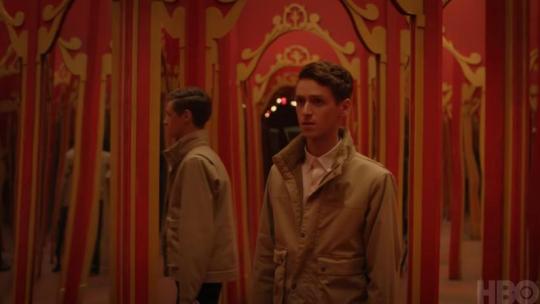
Feature
Books
Mike Cecchini
Nov 17, 2019
Watchmen
HBO
from Books https://ift.tt/2OpDobD
0 notes
Text
I want to content create but I won’t have much time tomorrow probably so I think I’ll rate every Neanderthal based piece of popular media I remember consuming.
Parameters ARE:
1) believability. writers love to give Neanderthals special abilities that no real animals have ever ever had. These once-living creatures absolutely would not have had the ability being ascribed.
2) characterization. The Neanderthals are written as real characters and not like a monolith or like a one-dimensional movie monster.
3) hybrids. Neanderthal/modern human hybridization plays an important role in the story.
4) interspecies sex. Almost always linked to #3. a higher score in this category or #3 does not necessarily indicate a greater quality piece of media. in fact, i personally dont prefer a lot of sexual content in the media i consume. however, these concepts show up so often in neanderthal stuff, its basically part of the genre.
5) accuracy. The attempt to accurately portray how Neanderthals and modern humans are different, and the quality of it’s execution.
1st up: clan of the cave bear by Jean M. Auel.
Brief summary: a modern human girl is found and raised by neanderthals.
Believability: 5. Book was obviously well researched, but was published in the 60’s and a lot has changed since then. Also they can remember the their ancestors memories. they also have limited ability to learn new things and life in strictly hierarchical societies based around biological sex, and have a universal language they are all born knowing.
Characterization: 9. 99% of characters are Neanderthals.
Hybrids: 8. Birth of hybrid baby very important to story.
Interspecies sex: 2. warning, non-graphic description of rape. Modern human/modern human Sex plays huge role in second book in series, hybrids/ interspecies sex was discussed also but never happened. Did not read past second book because of the sheer quantity of porn, but very little of that was in the first book.
Accuracy: 6. Does good job of differentiating Neanderthals from modern humans but once again, the science has changed since the book was published.
Neanderthal by John darton
Brief summary: scientists find secret location where neanderthals have survived to the modern day, journey to the center of the earth style.
Believability: 2. They are psychic and can see through each other’s eyes.
Characterization: 3. The Neanderthal characters don’t speak/ are more allegories for the progression of man or some shit.
Hybrids: 0. No mention or implication of hybrids.
Interspecies sex: 1. One iffy scene.
Accuracy: 4. Good differentiation between modern humans and Neanderthals. Good criptid vibe. But is it accurate? Hard to say.
Neanderthal parallax series by Robert j. Sawyer
Brief summary: neanderthal quantum physicist from an alternate universe where neanderthals survived and we did not falls through a portal to our world.
Believability: 4. They all supposedly see the most logical solution to a problem and just do it without making mistakes, because they just do. Also they're immune to the Pavlov’s dog learning test thing in psychology so they can all be atheists and it effects them in no other way. Come on now.
Characterization: 9. Many Neanderthal characters written as individual people.
Hybrids: 7. the conceiving of a hybrid child very important to last book.
Interspecies sex: 6. One sex scene in the second book, because there had to be one apparently. 4-6 more that are fade to black.
Accuracy: 4. You can tell the author did a lot of cursory googling, but large swaths of plot are based on incorrect assumptions. The author comes up with cool mechanics based on googleable theories, but the full implications of them are always half-baked.
The goblin reservation by Clifford d. Simak.
Brief summary: future college professor must solve mystery surrounding a dying alien planet in a sci-fi + fantasy setting. involves time travel.
Believability: 10. No fantastical powers ascribed.
Characterization: 10. There is one Neanderthal character in the book and he’s the best character in the book. Love him. Hybrids: 0. No mention or implication of hybrids.
Interspecies sex: 0. No mention or implication.
Accuracy: 5. The one Neanderthal character is treated as a character first and well written. However, it’s doubtful that the author put much effort into accuracy because the only differences between the Neanderthal and the other characters seem to be cultural. But the book was also published in the 60’s and he still holds up as a character, so maybe that’s a good thing. Could be accurate.
SPOILERS SPOILERS SPOILERS!!! The secrets of the immortal Nicolas flamel series by Michael Scott
Brief summary: a set of teen twins get caught up in saving the world from ancient mythological gods and shit. there are immortal humans too. sorry i remember very little of the overarching plot, but damn that twist ending.
Believability: 10. There’s magic in this series but Neanderthals don’t have it by virtue of being Neanderthals.
Characterization: 10. It is revealed in the end of the last book that the main teen boy in the series was a Neanderthal the entire time. There was zero indication of this before hand, so he is written as well as any main character in a teen fantasy novel.
Hybrids: 1?. It’s implied that Neanderthals are as much human/were absorbed into the modern human population eventually, but it’s pretty irrelevant to the story.
Interspecies sex: 1. Implied the way hybrids are implied. I don’t think the kid ever even had a girlfriend throughout the series either.
Accuracy: 2. no indication the author even knew Neanderthals are supposed to look a little different. The kid ends up being immortal and legendary, all kinds of crazy time powers and shit, all of it having more to do with being human than homo neanderthalensis. Being a Neanderthal is inconsequential to his being a normal angsty teen, legendary hero, and literal god. i doubt any neanderthal research was done, or at least it was not taken into account when writing the character.
Hominids by Jordan kotzebue (webcomic).
Brief summary: all species of hominids live in a jungle together. maybe the doing of sci-fi stuff? :o
Believability: 9. Neanderthals don't seem to have any special abilities. We will see what the sci-fi genre has to offer once the comic is finished..
Characterization: 8. Many Neanderthal characters, but writing isn't as strong as it could be in general.
Hybrids: 8. Hybrid pregnancy. We will see how it pans out, once again the comic is ongoing.
Interspecies sex: 5. Definitely happens at least once, but not an explicit comic (no porn). we will see if its important to the plot later on.
Accuracy: 8. Major differences between Neanderthals and modern humans are cultural. Also Neanderthals are drawn with waists. Experts agree that they were shaped like little barrels. does go out of its way to include other types of hominids though, so its a little educational.
and last but not least Neander-chan by Lemniskate on deviantart
Brief summary: neanderthal girl falls in love with modern human boy and attempts to stop their clans from killing each other. looks like the whole thing stemmed from a simple pun.
Believability: 8. they arent ascribed any wild abilities that couldnt also be ascribed to modern humans in the story. i dont think a ton of research was done though.
Characterization: 9. many neanderthal characters with differing personalities.
Hybrids: 2. definitely implied/foreshadowed as a thing that COULD happen should the story continue, however the comic might be complete as-is.
Interspecies sex: 7. definitely happens and is important to the story, but the comic is never explicit.
Accuracy: 5. has a bit of modern humans killing off neanderthals narrative, but the story is not designed to educate. the neanderthals could be replaced with a rival group of modern humans and the story wouldnt change.
neanderthal media i am aware of but have yet to consume:
the kroods (film): gotta get in on that nic cage action.
The Ugly Little Boy: originally a short story by Isaac Asimov, later expanded with collaborator Robert Silverberg. time travellers take a neanderthal boy away from his family to the present but he has to stay in a specialized room by himself all the time i think. gotta get in on that shit but could not find at library.
if you are aware of any other neanderthal-based media not listed anywhere in the above text please contact me at http://edge-lorde.tumblr.com/ask
thank you
#neanderthal#anthropology#clan of the cave bear#john darnton#rambling#thoughts#neanderthal parallax series#robert j sawyer#the alchemyst#the secrets of the immortal nicolas flamel#michael scott#the goblin reservation#clifford d simak#hominids#hominids comic#neander-chan#the kroods#The Ugly Little Boy#neanderthal book#neanderthal book review#book review
9 notes
·
View notes
Text
askhoennlegends replied to your post: @secretandstrange i like fantasy/fiction/sci fi/historical fiction!
Okay, yeah, we are definitely in my element, then!
I’m guessing you’ve probably already read (or are at least aware of) the kind of current standards, things like Terry Pratchett’s Discworld, anything by Neil Gaiman, probably Pullman’s His Dark Materials, but if for some reason you haven’t (other than straight-up, “I have reasons to suspect they aren’t my thing,” which I can respect), I’ll get more specific on those. ^^
Io9 regularly puts out lists of upcoming books, often with reviews, and sometimes even excerpts, so I’d also recommending checking that out, because they’re a lot more on the ball with new stuff than I am!
All the things I’m going to rec for you now are older (I think mostly from the 70s to the 90s or so), so I don’t know if that’ll make it more likely you’ll already have come across them, or less. I don’t know what Teh Kids are picking up anymore. ^^; (Behind a cut, because this got long!)
Bernard Cornwell’s The Warlord Chronicles (The Winter King, Enemy of God, & Excalibur) is one of my favourite series to introduce to people who don’t know it already - it’s his retelling of the Arthurian legends, but much more on the dark and gritty side than the mystical and romantic. It’s set in very early medieval Britain, it’s as much political (warring kingdoms and true heirs and the like) as it is magical, and even the magic has more basis in what humans have actually practiced than full-on wand-waving wizard magic (there’s some of that, too, but still filtered through a more historic lens than a fantastic one).
The warning I’ll give for those is that they’re graphic af - a lot of gory illnesses and wounds, war, death, at least a bit of sexual content (ti’s been a few years since my last re-read and I can’t remember how explicit it is on that front, but I’d say less descriptively sexual than descriptively violent), and there’s some paganism vs Christianity stuff throughout that gets stronger toward the end (including a coerced conversion).
Connie Willis’ Doomsday Book is a sci-fi/historical fiction mix (time travel that switches between story in the near-future and the Middle Ages). It’s not particularly graphic, but some of the major plot points concern illness and death. It’s rather sad in places, and does touch on some issues like the arranged marriage of a teenager (again without being overly graphic), but I enjoyed it enough to re-read it repeatedly (particularly when I was getting ready to head up to the Ren Faire). She has at least one other set in the same universe (To Say Nothing of the Dog) that I believe travels to the Civil War era, but I’ve never managed to get my hands on it and couldn’t say if it’s as good or not. (I should remedy that, really!)
Gregory Maguire’s The Wicked Years - adult retellings of the Wizard of Oz, what the musical Wicked was based on. They’re again on the darker side of things, probably do need some disclaimers about violence, questionable dynamics, sexuality, so that’s one for the “If you like those kind of dark adult themes” pile. He does some other twisted fairy tale stuff, too.
I pretty much raised myself into adult sci-fi/fantasy with Anne McCaffrey - primarily the Dragonriders of Pern series, a lot of which feels much more fantasy than sci-fi (though it turns out, as you go on, that it is indeed the latter [not to suggest the two are mutually-exclusive, but - well, it’s hard to explain why without spoilers!]). She wrote many, many books for it, and I didn’t particularly care for the later ones, but the others I absolutely wore out. Dragonflight and Dragonquest were written first and if you start with them, you’ll get the same “discovery” experience as the characters, without knowing any of the world history that lead to that point. The Harper Hall trilogy is set around the same time and was where I started myself, along with Moreta, Dragonlady of Pern, which takes place somewhat earlier in the world’s history. Dragonsdawn is the “how this all started” book, and The White Dragon and All the Weyrs of Pern would optimally be read after those others, both because that’s chronologically when they take place, and because Weyrs in particular changes the world dramatically. (Those are kind of the ‘core’ books; like I said, there are bazillions of others.) I started reading them when I was twelve or so and there was never anything I found upsetting, so I don’t know if there’s any kind of warning I need to put on them or not.
She also wrote ‘harder’ sci-fi (more focused on things like technology and space travel) - The Pegasus trilogy is mostly set on Earth and deals with the awakening and government management of psychic powers, and leads to the Tower and Hive books, which are set farther in the future and include space colonization and first contact along with the psychic stuff. (Pegasus in Flight has plot points of child trafficking and forced population control.) The Acorna series is about a ‘unicorn girl’. In space. Crystal Singer, the Ship Who and City Who books, all of those are straight-up sci-fi with standard sci-fi tropes and I don’t recall them being particularly offensive (but it has been YEARS since I touched any of those); she’s got some other stuff, but those were what I had.
Dragonlance I was always fond of (D&D-based, standard fantasy tropes; definitely start with the Chronicles and Legends; everything else is expansion from there); David Eddings’ Elenium and Tamuli trilogies (warnings for some class and racial stuff, slavery, and a consensual romance with a sizeable age gap); Brian Jacques’ Redwall series (don’t let the cute animals fool you; they're quite serious books)...
If you know of Howl’s Moving Castle from the Studio Ghibli movie but not the book, the book! It (along with its sequel and Diana Wynne Jones’s other wizard series, the Chrestomanci Chronicles) is traditionally for younger readers, and from the era before young adult stuff got darker than grown-up books, but I always liked them. (In the same “younger readers” vein, but in this case absolute teenage girl trash, The Secret of the Unicorn Queen. Six books about a high school girl getting dumped into a fantasy world, all the standard Mary Sue stuff, complete tripe, and I absolutely loved them.)
(Not that I'm under the impression you’re teenage girl trash! I’m just trying to think of some things that are more “light reading/kind of silly” to offset all the harder/darker stuff. ^^ I hope at least something here will hit the mark, either way!)
0 notes
Text
Sensor Sweep: Schuyler Hernstom, Ken Kelly, Gardner Fox, August Derleth
Review (Brain Leakage): In terms of pure entertainment, I can’t recommend Hernstrom’s story enough. And if all you’re craving is a dose of pure, adrenaline-filled awesomeness with alien ruins, axe-wielding barbarians, motorcycles, and talking monkeys, then stop reading this review NOW. Buy Hernstrom’s new collection, The Eye of Sounnu from DMR Books, which is where you can read this slice of pure heavy-metal havoc. I promise, you won’t be disappointed.
Art (David J. West): I am positive that Ken Kelly has done more book covers that I own than anybody else – and that’s a lot considering I typically buy every Frazetta I can find. Kelly is such a work horse and has done so many Conan’s and other sword and sorcery related covers that it is staggering. He has done a lot of heavy metal covers too, but I don’t think I have any of those but when it comes to book covers wow -its staggering.
Interview (The Dacian): To kick off the series I asked my favorite living Sword & Sorcery writer Schuyler Hernstrom to be my first subject. Over the weekend Hernstrom took the time to chat and answer a few questions. Schuyler Hernstrom is a fantastic writer of Sword & Sorcery whose recent short story collection The Eye of Sounnu I review here, and made the subject of the first Short Story Bookclub. You can also read his previous collection Thune’s Vison and he’s been featured numerous times in Cirsova Magazine, including the upcoming summer special.
Forthcoming (Story Hack): I recently annouced that I’ll be publishing a collection of short stories by the ever-entertaining Misha Burnett. It will release on June 15th. This collection features reprints as well as new work. And now, you can preorder the ebook version on Amazon. Paperback will also be available, but there won’t be a preorder. For those of you who do buy a paperback, I’ll make available bookplates signed by the author. Details on that to follow.
Men’s Adventure Magazines (Menspulps.com): Most of the magazines in the war mag subgenre were fairly short-lived (as were many other magazines in the men’s adventure genre in general). The longest-lasting was BATTLE CRY. It was published from late 1955 to mid-1971 by Stanley Publications, Inc., the flagship company of pioneering comic book and magazine publisher Stanley P. Morse. When the puritanical 1954 Comics Code essentially banned violent or sexy images in comics, Morse discontinued his BATTLE CRY comic book and created the men’s adventure magazine BATTLE CRY.
Fiction (Goodman Games): May 20th is the birthdate of Gardner F. Fox. But when people see his name on the list of Appendix N authors, there’s often no recognition of his name as a writer of fantasy. He has passed into relative obscurity for contemporary fans of the genre. It is not surprising considering that he is best known as the author of the Kothar books (discounted by many as a cheap knockoff of Conan) and the Kyric books (a likewise discounted knockoff of Elric).
Science Fiction (M Porcius): A. E. van Vogt has many detractors, and their criticisms are not all off base; you might say the Slan man, Canada’s finest export, is an acquired taste. You don’t read A. E. van Vogt looking for conventional literary values, like beautiful sentences. And you don’t read A. E. van Vogt looking for the comforts of standard popular fiction, like sympathetic characters you enjoy “getting to know” who share your values and regurgitate the conventional wisdom. An A. E. van Vogt story is usually challenging on multiple levels.
Art (DMR Books): However, Angus was painting fantasy art long before he was doing work for RPG publishers. During the 1960s, McBride was creating art steadily for Look and Learn magazine as well as its competitor, Finding Out. Both were aimed at a juvenile/young adult audience, but the art and writing in them were well above what one would find in similar publications today.
D&D (Jeffro’s Space Gaming Blog): Just looking over these old sessions and I have to say, it really takes my breath away: The Hole in the Sky, The Thing in the Sewer, The Big Score, The Drums of the Dog People, Altar of the Beast-women, The Pugs of Slaughter, The Overbearing of the Crystal Men, The Song of Fàgor.
Comic Books (Messages From Crom): Ablaze Publishing THE CIMMERIAN: PEOPLE OF BLACK CIRCLE #1 Coming in August! Robert E. Howard’s Conan is brought to life UNCENSORED! Discover the true Conan, unrestrained, violent, and sexual. Read the story as he intended! In the kingdom of Vendhya, the king has just died, struck down by the spells of the black prophets of Yimsha. The king’s sister, Yasmina, decides to avenge him…and contacts Conan, then chief of the Afghuli tribe.
Science Speculation (Pulprev): In the world of Singularity Sunrise, where robotics and AI threaten to replace humans in every major field, one of the few things that cannot be quantified, mechanised and reproduced by machines is psychic powers. Don’t expect Hollywood-or anime-type powers here. In this universe, psychic powers are the outgrowth of research projects like Project Stargate, investigating the potential of the mind to gather information through extra-sensory perception.
Video Games (Kairos): The Internet Archive even has every back issue of Nintendo Power, so the re-creations of those long-lost after school decompression sessions with a new kart slotted in my SNES, a crisp copy of NP flopped open on the couch, and a bowl of popcorn in my lap are almost perfect. Archive.org doesn’t call its old web site search feature the Wayback Machine for nil. One thing that hits you over the head when you go back and play the old 2D sprite-based games is the real craftsmanship behind the bright colors and pixels.
Fiction (Paperback Warrior): Esteemed author Max Allan Collins is a heavy contributor to the gritty hard-boiled line of mystery fiction. His well-respected creations include Nate Heller, Nolan, Mallory and the subject at hand, Quarry. The Thrilling Detective blog cites Quarry as the first hired killer series, predating Loren Estleman’s Peter Macklin and Lawrence Block’s Keller. Collins released the debut, The Broker (aka Quarry), in 1976. After four more novels, and a ton of fan mail requests, the author began releasing series installments again in 2006.
Poul Anderson (Mystery File): POUL ANDERSON “The Martian Crown Jewels.” Short story. Freehatched Syaloch #1. First published in Ellery Queen’s Mystery Magazine, February 1958. One reason for the story’s popularity, I think, is that there really aren’t many examples of combining traditional detective stories with hardcore SF, and this is a good one. The detective on the case is Martian private detective Freehatched Syaloch, but this seems to have been his only appearance in print. Missing are the Martian crown jewels, which have been on display on Earth, but on their state secret return to Mars, via Phobos, one of the planet’s moons, they have completely disappeared.
Horror (Grady Hendrix): Wilson’s The Keep deals with Judaism more obliquely and in the guise of the big, fat, international thrillers authors like Robert Ludlum were popularizing in the early Eighties. A swaggering, World War II adventure story full of warring immortals, sneering Gestapo officers, magic swords, and Weighty Questions about Faith, The Keep arrived as the smaller novels of the Seventies started giving way to the massive blockbusters of the Eighties. Painted in broad strokes on a big canvas, The Keep fits comfortably into a decade that would make literary rock stars out of authors like Anne Rice and Stephen King.
Weird Tales (Dark Worlds Quarterly): August Derleth takes a lotta crap. Some of it is deserved but some of it isn’t. Like when people say Derleth wouldn’t have been in Weird Tales without Lovecraft. That is simply not true. August’s first Weird Tales appearance was “Bat’s Belfry” (Weird Tales, May 1926), eleven years before Lovecraft’s death. His first Mythos tale was “The Lair of the Star-Spawn” (Weird Tales, August 1932) with Marc R. Schorer. This story appeared during HPL’s lifetime. Derleth had written forty stories previously to Star-Spawn. He wouldn’t write a posthumous Mythos tale until his seventy-second, “The Return of Hastur” (Weird Tales, March 1939), the year Arkham House began publishing. Of Derleth 132 appearances in WT, only 15 were Cthulhu Mythos (with one other appearing at Strange Tales). That means Derleth appeared in 40% of all issues.
D&D (Goblin Punch): The most interesting part for most of you will probably be the Advice for DMs section, but I’m posting the whole thing here since it’s a good explanation of (a) old-school dungeoncrawls, as I see them, and (b) the style of gameplay that I’m shooting for in the Lair of the Lamb.
Writing (Amatopia): A corollary to my recent post about villains who may have had a point after all: I am not advocating for the “sympathetic villain” trope. In fact, I generally dislike that trope. But I have a theory that a lot of new and new-ish writers can’t help but write villains like this because they forgot how to make heroes actually heroic. This is not because our traditional culture is bad and out if step with the times. It’s because a cadre of nihilistic relativists hijacked the culture with the intent of changing it to suit their own spiritual and psychological hangups. It’s a tale as old as time.
Cinema (Giant Freakin Robot): Starship Troopers should have been a gargantuan hit. With a $100m+ budget and the director behind sci-fi triumphs like RoboCop and Total Recall, the adaptation of Robert Heinlein’s 1959 novel was poised to be a smash hit both financially and critically. That’s not what went down in 1997. We have to understand that the movie-going public was very different in 1997. Films were sold on their stars more than their premises. If you look at the biggest earners of the year, you’ll see movies whose marketing campaigns were structured around their lead actors: Men in Black, Liar Liar, Air Force One, My Best Friend’s Wedding.
Sensor Sweep: Schuyler Hernstom, Ken Kelly, Gardner Fox, August Derleth published first on https://sixchexus.weebly.com/
0 notes
Text
A-Z: Peter Barnard

Our ongoing A-Z series continues with Peter Barnard based in the UK. Using a multiform approach, Peter's work consistently varies in forms and appearances, from sculpture to sound installations, from performances to film and video works. Let's have a look at his alphabets and see what makes him as an artist:
A for Automatic Writing by Robert Ashley.
Experimental music that was composed
from Ashley’s involuntary speech as a result of having a mild form of Tourette's
Syndrome. Quiet, unintelligible outbursts by Ashley himself paired with the voice of a woman whispering in French against a background of a Polymoog synthesiser, delicate organ drones and throbbing bass sounding as if its coming from another room. Cryptic and oddly calming to listen to.
B for Berlin.
One of my favourite cities to visit.
C for Chance.
A creative method that I often use in my art-making. Embracing the
accidental, the spontaneous or the completely random to make art happen.
D for dataplex by Ryoji Ikeda.
Uncomprisingly minimalistic electronic music.
youtube
E for EVP. EVP or Electronic Voice Phenomenon.
A theory within parapsychology that suggests sounds heard in electronic recordings may be that of spirits communicating from beyond the grave.
Originally popularized by Parapsychologist Konstantīns Raudive in the 1970s and used as a technique by ghost hunters. While I regard myself as a sceptic towards the paranormal, this form of auditory pareidolia still fascinates me as it suggests that the brain is able to recognise patterns in randomised
signals heard in white noise or static. There is an excellent book by Joe Banks (of Disinformation), Rorschach Audio, which goes into depth about the history of EVP and aural perception.
F for Fog line (1970) by Larry Gottheim.
Beautiful piece of structural film consisting of a static shot of an outdoor scene that slowly unravels itself as the fog lifts.
youtube
G for Glitch.
An aesthetic form that embodies the ‘warts and all’ of technology. From the hiss
and crackle of old vinyl records to corrupted pixels on faulty LCD monitors, glitch art also shares similar historical grounds with art that used automatism and chance as a creative strategy.

Takeshi Murata, Monster Movie, still, (2005)
Listen to: https://soundcloud.com/peterbarnard/variations-on-silence-2015
H for Harmony In Ultraviolet.
Favourite album by Tim Hecker. Abstract and deeply evocative soundscapes.
youtube
I for “I am Sitting in A Room” (1969) by Alvin Lucier.
One of his best-known works. A phenomenal piece of process-based music where recorded speech is played into a space and recorded again until the
speech patterns gradually turn into resonating frequencies.
J for Jannis Kounellis.
A pillar of the Italian Arte Povera movement noted for his works that
incorporated unconventional materials that ranged from jute bags, charred pieces of wood, sheets of lead, fire to live musicians and controversially, animals.

K for Krapp's Last Tape (1958).
One act play by Samuel Beckett centred around a monologue delivered by an elderly man as he listens to a set of reel to reel tapes, each containing recordings of his voice in his younger days.
youtube
L for listen.
“The word 'listen' contains the same letters as the word 'silent'.”- Alfred Brendel
M for Measure by Measure by Susan Hiller.
On-going work consisting of measuring glass tubes that contain the ashes of paintings burnt by the artist on an annual basis.

N for Noise.
“Wherever we are, what we hear is mostly noise. When we ignore it, it disturbs us. When we listen to it, we find it fascinating. The sound of a truck at fifty miles per hour. Static between the stations. Rain. We want to capture and control these sounds, to use them not as sound effects but as musical
instruments. Every film studio has a library of 'sound effects' recorded on film. With a film phonograph it is now possible to control the amplitude and frequency of any one of these sounds and to give to it rhythms within or beyond the reach of the imagination. Given four film phonographs, we can compose and perform a quartet for explosive motor, wind, heartbeat, and landslide” -
John Cage
O for Openness.
P for Plunderphonics. Coined by Composer John Oswald in his 1985 essay, Plunderphonics, or Audio Piracy as a Compositional Prerogative, Plunderphonics refers to the act of taking fragments from pre-existing music/sound recordings and altering these to form a new work.
youtube
Q for Questioning
R for Radio.
I frequently use radio technology as a source for sounds to use as
material to create works. Its indeterminate nature and ability to transmit signals over a long distance has long served as a rich field for artists, poets, musicians,
composers and writers. From John Cage, Hildegard Westerkamp, Samuel Beckett, Chris Watson to Scanner and Magz Hall.
S for Sonambient.
A term defined by the Italian American sculptor, furniture designer
and printmaker, Harry Bertoia to describe the tonal and spatial qualities of his sound sculptures. Many of these works consisted of vertical metal rods on flat bases that would generate multifaceted harmonic overtones when played by hand or the elements. He then later renovated an old barn into a concert hall for these sculptures to be played like an orchestra while making a number of recordings of the sounds produced.
T for The Great Learning by Cornelius Cardew and the Scratch Orchestra.
U for Ubik by Philip K Dick.
Both simultaneously surreal and disturbing as a sci-fi novel set in 1992
where humans have colonised the moon and have psychic powers. Throw in some satire fused with dark humour and existentialism and you will have a total mind screw of a novel.
V for Variations.
W for Walking.
An act that I find often very conducive to bringing about new ideas for work.

Stanley Brouwn, Pedestrian Footsteps on Paper, 1960.
X for Xenakis.
Y for Yhä hämärää by Paavoharju.
Wonderfully weird psychedelic folk from Finland with ambient elements thrown for good measure.
Z for Zeit by Tangerine Dream.
Growing up as a teenager listening to mostly rock music, hearing this album the first time was almost a revelation for me. Using a combination of droning synths, organs and a quartet of cellos, Tangerine Dream create a set of lengthy, beatless tracks that seem to lull the listener into soundscapes that evoke the vast expanse of deep space and what might lie beyond. Eerie and monolithic.
To find out more about Peter Barnard's works, check out his website: https://www.peterbarnard.net/
1 note
·
View note